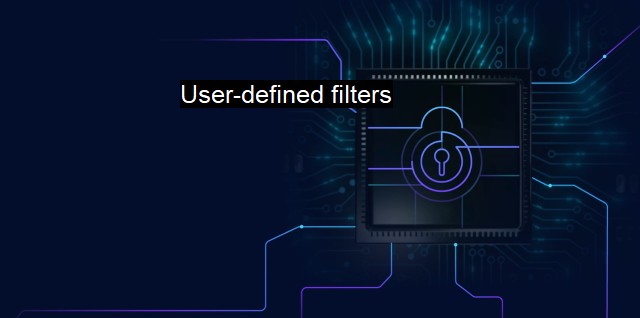What are User-defined filters?
Empowering Cybersecurity: The Vital Role of User-Defined Filters in Protecting Electronic Devices and Networks
User-defined filters are a critical component of an overall cybersecurity strategy, aimed at protecting computer systems from harmful viruses and various other types of cyber threats. This generic term refers to customized filtration rules or criteria for tackling unexpected, undefined, suspicious traffic and patterns, thereby granting users the liberty to maintain a higher level of control on their data and systems.These filters work to sift through all forms of data and isolate those items or activities that are identified as potential threats or reflected in the filter’s pre-set parameters.
User-defined filters fall into multiple categories based on their specific purpose. These include not only those that work at a user-interface level, but also ones which work in the back-end as alert mechanisms or mitigate actions in real-time. A common example of a user-defined filter is one that filters out certain IP addresses or regions to prevent unauthorized traffic from those areas.
Among the value propositions for user-defined filters is how it enhances cybersecurity by deploying advanced tools and strategies to anticipate possible adversarial attacks. These filters help this aspect of cybersecurity by involving the end-users actively in monitoring and shielding their systems from threats.
Interestingly, user-defined filters also lighten the overwhelming job of cybersecurity professionals who work within an expanded threat landscape. Having defined and automated rules and thresholds reduces the partition of false-positive alerts, making management more efficient and decreasing response times whenever threats present themselves.
User-defined filters take into account key user behavioural patterns and context, enabling them to tailor protection measures that are unique to a particular user or enterprise system. This also offers protection against increasingly sophisticated malware which often requires more than generic solutions to spot and disarm.
User-defined filters are not without challenges. Creating these filters requires a good understanding of the average network’s usage patterns and disciplined adherence to data governance policies. It also highlights the often-overlooked necessity for continuous learning, updates and rigorous testing since cybersecurity is an ever-evolving landscape. An incorrect configuration can exacerbate vulnerabilities, making thoughtful user involvement much more important.
User-defined filters offer a renewable resource in fighting against cyber threats. The more filters are utilized and the more feedback they generate helps their designers create progressively more sophisticated and focused filters in response to changing threats.
From another angle, user-defined filters enhance privacy and data integrity by curbing potential inbound and outbound traffic leaks. Individuals and businesses that leverage privacy filters can exert more control, thus safeguarding sensitive data that may lead to breaches if dealt with carelessly.
In the arena of antivirus, user-defined filters serve an important function in scanning systems and software applications for threats. Users can define the degree of scrutiny they want their antivirus scans to have.
The antivirus software’s user-defined filters, therefore, provide individuals with the power to take charge of their system security beyond the antivirus software’s default protection guidelines making security more granular and attuned to peculiar needs.
User-defined filters can supplement both cybersecurity and policies and antivirus systems. In an era when threats continue to grow in diversity and complexity, user-defined filters offer a way for users to be proactive. They equip individuals and organizations with the agility to define their security thresholds and rules, forming essential packs of their tailored defence strategy against cyber threats.

User-defined filters FAQs
What are user-defined filters in antivirus software?
User-defined filters in antivirus software refer to custom rules or parameters set by the user to identify and block specific types of threats. These filters can be created based on a variety of criteria, such as file type, size, location, or behavior, and can help enhance the security of a system by targeting threats that may not be detected by default antivirus settings.How do I create a user-defined filter in my antivirus software?
The process for creating a user-defined filter varies depending on the antivirus software you are using. Typically, it involves accessing the settings or options menu of the software and navigating to the "Filters" or "Custom Rules" section. From there, you can specify the parameters for the filter, such as the file type or behavior you want to block, and save the settings.Can user-defined filters in antivirus software be updated or modified?
Yes, user-defined filters can be updated or modified at any time to reflect changes in the threat landscape or the needs of the user. This may involve adding new parameters to an existing filter, creating a new filter based on a different set of criteria, or removing or disabling a filter that is no longer needed.Do user-defined filters replace or supplement default antivirus settings?
User-defined filters supplement default antivirus settings, rather than replacing them. While default settings provide a basic level of protection against known threats, user-defined filters allow users to customize their antivirus software to detect and block specific types of threats that may be unique to their environment or use case. This can help enhance the overall effectiveness of the antivirus software in preventing cyber attacks.| | A | | | B | | | C | | | D | | | E | | | F | | | G | | | H | | | I | | | J | | | K | | | L | | | M | |
| | N | | | O | | | P | | | Q | | | R | | | S | | | T | | | U | | | V | | | W | | | X | | | Y | | | Z | |
| | 1 | | | 2 | | | 3 | | | 4 | | | 7 | | | 8 | | |||||||